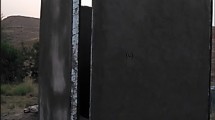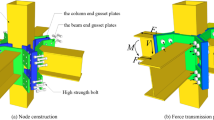Abstract
This paper investigates the seismic response of lightly reinforced precast concrete shear walls typically used for low- to mid-rise residential systems in past and current Dutch building practice. The results of a wide set of pseudostatic cyclic tests performed on full-scale single precast panels with or without openings were examined and discussed, quantifying the sensitivity of structural response and failure mode to changes in axial load and wall geometry. Behavioral aspects of those panels were treated at a global/structural and local/sectional level, posing particular emphasis on their wall-to-foundation and wall-to-wall joints. Asymmetric push–pull tests of precast wall connections were also carried out and presented to characterize the cyclic behavior of this type of joint system under simulated seismic loading. The outcome of this large campaign of experimental tests was then used to develop and validate a simple numerical model to be integrated in a framework for large scale seismic fragility analysis of precast terraced structures built with this particular technology.




























Similar content being viewed by others
References
Antoniou S, Pinho R (2004) Development and verification of a displacement-based adaptive pushover procedure. J Earthq Eng 8(5):643–661
Belleri A, Riva P (2012) Seismic performance and retrofit of precast grouted sleeve connections. PCI J 57(1):97–109
Belleri A, Schoettler MJ, Restrepo JI, Fleischman RB (2014) Dynamic behavior of rocking and hybrid cantilever walls in a precast concrete building. ACI Struct J 111(3):661–671
Belleri A, Brunesi E, Nascimbene R, Pagani M, Riva P (2015) Seismic performance of precast industrial facilities following major earthquakes in the Italian territory. J Peform Constr Facil ASCE 29(5):04014135
Belleri A, Torquati M, Marini A, Riva P (2016) Horizontal cladding panels: in-plane seismic performance in precast concrete buildings. Bull Earthq Eng 14(4):1103–1129
Beyer K, Dazio A, Priestley MJN (2008) Inelastic wide-column models for U-shaped reinforced concrete walls. J Earthq Eng 12(S1):1–33
Biondini F, Dal Lago B, Toniolo G (2013) Role of wall panel connections on the seismic performance of precast structures. Bull Earthq Eng 11(4):1061–1081
Bommer JJ, Crowley H, Pinho R (2015) A risk-mitigation approach to the management of induced seismicity. J Seismol 19(2):623–646
Bournas DA, Negro P, Molina FJ (2013) Pseudodynamic tests on a full-scale 3-storey precast concrete building: behavior of the mechanical connections and floor diaphragms. Eng Struct 2013(57):609–627
Brunesi E, Nascimbene R (2014) Extreme response of reinforced concrete buildings through fiber force-based finite element analysis. Eng Struct 69:206–215
Brunesi E, Nascimbene R, Bolognini D, Bellotti D (2015a) Experimental investigation of the cyclic response of reinforced precast concrete framed structures. PCI J 60(2):57–79
Brunesi E, Nascimbene R, Deyanova M, Pagani C, Zambelli S (2015b) Numerical simulation of hollow steel profiles for lightweight concrete sandwich panels. Comput Concr 15(6):951–972
Brunesi E, Nascimbene R, Parisi F, Augenti N (2015c) Progressive collapse fragility of reinforced concrete framed structures through incremental dynamic analysis. Eng Struct 104:65–79
Brunesi E, Nascimbene R, Pavese A (2016) Mechanical model for seismic response assessment of lightly reinforced concrete walls. Earthq Struct 11(3):461–481
CEN, European Committee for Standardization (2004a) EN 1992-1-1. Eurocode 2 (EC2): design of concrete structures—part 1.1: general rules and rules for buildings. Brussels, Belgium
CEN, European Committee for Standardization (2004b) EN 1998-1-5. Eurocode 8 (EC8): design of structures for earthquake resistance—part 1.5: specific rules for concrete buildings. Brussels, Belgium
Crisafulli FJ, Restrepo JI, Park R (2002) Seismic design of lightly reinforced precast rectangular wall panels. PCI J 47(4):104–121
Crowley H, Pinho R, Bommer JJ (2004) A probabilistic displacement-based vulnerability assessment procedure for earthquake loss estimation. Bull Earthq Eng 2(2):173–219
Dal Lago B, Toniolo G, Lamperti Tornaghi M (2016) Influence of different mechanical column-foundation connection devices on the seismic behaviour of precast structures. Bull Earthq Eng 14(12):3485–3508
Dal Lago B, Biondini F, Toniolo G (2017a) Experimental investigation on steel W-shaped folded plate dissipative connectors for horizontal precast concrete cladding panels. J Earthq Eng. doi:10.1080/13632469.2016.1264333
Dal Lago B, Biondini F, Toniolo G, Lamperti Tornaghi M (2017b) Experimental investigation on the influence of silicone sealant on the seismic behaviour of precast façades. Bull Earthq Eng 15(4):1771–1787
Dazio A, Beyer K, Bachmann H (2009) Quasi-static cyclic tests and plastic hinge analysis of RC structural walls. Eng Struct 31:1556–1571
De Borst R (1987) Smeared cracking, plasticity, creep and thermal loading—a unified approach. Comp Meth Appl Mech Eng 62(1):89–110
Englekirk RE (2003) Seismic design of reinforced and precast concrete buildings. Wiley, New York
EOTA, European Organization for Technical Approvals (2010) ETAG 001: guideline for european technical approval of metal anchors for use in concrete—annex C: design methods for anchorages. Brussels, Belgium
Fédération Internationale du Béton (fib), Bulletin 43 (2008) Structural connections for precast concrete buildings. Lausanne, Switzerland: fib, federation internationale du béton
Fintel M (1995) Performance of buildings with shear walls in earthquakes in the last thirty years. PCI J 4(3):62–80
Fischinger M, Kramar M, Isakovic T (2008) Cyclic response of slender RC columns typical of precast industrial buildings. Bull Earthq Eng 6(3):519–534
Ghobarah A, Youssef M (1999) Modelling of reinforced concrete structural walls. Eng Struct 21(10):912–923
Hidalgo PA, Ledezma CA, Jordan RM (2002) Seismic behavior of squat reinforced concrete shear walls. Earthq Spectra 18(2):287–308
Holden T, Restrepo J, Mander JB (2003) Seismic performance of precast reinforced and prestressed concrete walls. J Struct Eng ASCE 129(3):286–296
Hung C-C, El-Tawil S (2010) Hybrid rotating/fixed-crack model for high performance fiber reinforced cementitious composites. ACI Mater J 107(6):568–576
Kaldjian MJ (1967) Moment-curvature of beams as Ramberg-Osgood functions. J Struct Div ASCE 93(ST5):53–65
Kang S-M, Kim O-J, Park H-G (2013) Cyclic loading test for emulative precast concrete walls with partially reduced rebar section. Eng Struct 56:1645–1657
Kurama Y, Sause R, Pessiki S, Lu LW (1999) Lateral load behavior and seismic design of unbonded post-tensioned precast concrete walls. ACI Struct J 96(4):622–632
Li B, Qian K, Wu H (2016) Flange effects on seismic performance of reinforced concrete squat walls with irregular or regular openings. Eng Struct 110:127–144
Magliulo G, Ercolino M, Petrone C, Coppola O, Manfredi G (2014) The Emilia earthquake: seismic performance of precast reinforced concrete buildings. Earthq Spectra 30(2):891–912
Magliulo G, Ercolino M, Manfredi G (2015) Influence of the cladding panels on the first period of one-storey precast building. Bull Earthq Eng 13(5):1531–1555
Mander JB, Priestley MJN, Park R (1988) Theoretical stress-strain model for confined concrete. J Struct Eng ASCE 114(8):1804–1826
Mousavi SA, Zahrai SM, Bahrami-Rad A (2014) Quasi-static cyclic tests on super-lightweight EPS concrete shear walls. Eng Struct 65:62–75
Nederlands Normalisatie-instituut (2011) National annex to NEN-EN 1990 + A1 + A1/C2: eurocode: basis of structural design. Delft, the Netherlands
Otani S (1981) Hysteresis models of reinforced concrete for earthquake response analysis. J Fac Eng 36(2):407–441
Palermo M, Trombetti T (2016) Experimentally-validated modelling of thin RC sandwich walls subjected to seismic loads. Eng Struct 119:95–109
Palermo M, Gil-Martín LM, Trombetti T, Hernandez-Montes E (2013) In-plane shear behaviour of thin low reinforced concrete panels for earthquake reconstruction. Mater Struct 46(5):841–856
Palermo M, Ricci I, Silvestri S, Gasparini G, Trombetti T, Foti D, Ivorra S (2014) Preliminary interpretation of shaking-table response of a full-scale 3-storey building composed of thin reinforced concrete sandwich walls. Eng Struct 76:75–89
Pavese A, Bournas DA (2011) Experimental assessment of the seismic performance of a prefabricated concrete structural wall system. Eng Struct 33:2049–2062
Peng Y-Y, Qian J-R, Wang Y-H (2016) Cyclic performance of precast concrete shear walls with a mortar-sleeve connection for longitudinal steel bars. Mater Struct 49(6):2455–2469
Priestley MJN, Sritharan SS, Conley JR, Pampanin S (1999) Preliminary results and conclusions from the PRESSS five-story precast concrete test building. PCI J 44(6):42–67
Psycharis IN, Mouzakis HP (2012a) Shear resistance of pinned connections of precast members to monotonic and cyclic loading. Eng Struct 41:413–427
Psycharis IN, Mouzakis HP (2012b) Assessment of the seismic design of precast frames with pinned connections from shaking table tests. Bull Earthq Eng 10(6):1795–1817
Rezaifar O, Kabir MZ, Taribakhsh M, Tehranian A (2008) Dynamic behaviour of 3D panel single-storey system using shaking-table testing. Eng Struct 30:318–337
Ricci I, Palermo M, Gasparini G, Silvestri S, Trombetti T (2013) Results of pseudo-static tests with cyclic horizontal load on cast in situ sandwich squat concrete walls. Eng Struct 54:131–149
Rodríguez M, Blandón J (2005) Tests on a half-scale two-story seismic-resisting precast concrete building. PCI J 50(1):94–114
Rodriguez ME, Restrepo JI, Carr AJ (2002) Earthquake-induced floor horizontal accelerations in buildings. Earthq Eng Struct Dyn 31(3):693–718
Salonikios TN, Kappos AJ, Tegos IA, Penelis GG (1999) Cyclic load behavior of low-slenderness R/C walls: design basis and test results. ACI Struct J 96(4):649–660
Salonikios TN, Kappos AJ, Tegos IA, Penelis GG (2000) Cyclic load behavior of low-slenderness R/C walls: failure modes, strength and deformation analysis, and design implications. ACI Struct J 97(1):132–141
Seismosoft (2016) SeismoStruct—a computer program for static and dynamic nonlinear analysis of framed structures. URL: www.seismosoft.com
Silva V, Crowley H, Pinho R, Varum H (2013) Extending displacement-based earthquake loss assessment (DBELA) for the computation of fragility curves. Eng Struct 56:343–356
Spacone E, Filippou FC, Taucer FF (1996) Fibre beam-column model for non-linear analysis of RC frames: part I. Formulation. Earthq Eng Struct Dyn 25:711–725
Todut C, Dan D, Stoian V (2014) Theoretical and experimental study on precast reinforced concrete wall panels subjected to shear force. Eng Struct 80:323–338
Toranzo LA, Restrepo JI, Mander JB, Carr AJ (2009) Shake-table tests of confined-masonry rocking walls with supplementary hysteretic damping. J Earthq Eng 13(6):882–898
Tsoukantas SG, Tassios TP (1989) Shear resistance of connections between reinforced concrete linear precast elements. ACI Struct J 86(3):242–249
Vintzeleou EN, Tassios TP (1987) Behavior of dowels under cyclic deformations. ACI Struct J 84(1):18–30
Wiebe L, Christopoulos C (2010) Characterizing acceleration spikes due to stiffness changes in nonlinear systems. Earthq Eng Struct Dyn 39(14):1653–1670
Zoubek B, Fischinger M, Isaković T (2016) Cyclic response of hammer-head strap cladding-to-structure connections used in RC precast building. Eng Struct 119:135–148
Acknowledgements
This paper describes an activity that is part of the “Numerical and experimental evaluation of the seismic response of precast wall connections” project at Eucentre, undertaken within the framework of the research program for hazard and risk of induced seismicity in Groningen sponsored by the Nederlandse Aardolie Maatschappij BV. The authors would like to thank all the parties involved in this project: DICAr Lab of University of Pavia and Eucentre Lab that performed the test, together with NAM, Arup and TU Delft. Moreover, the authors are deeply indebted to Prof. Alberto Pavese, Dr. Filippo Dacarro and Dr. Simone Peloso for the extensive comments given on this research. Lastly, the authors are sincerely thankful to Dr. Giulia Fagà for the insightful support with figure editing.
Author information
Authors and Affiliations
Corresponding author
Rights and permissions
About this article
Cite this article
Brunesi, E., Nascimbene, R. Experimental and numerical investigation of the seismic response of precast wall connections. Bull Earthquake Eng 15, 5511–5550 (2017). https://doi.org/10.1007/s10518-017-0166-y
Received:
Accepted:
Published:
Issue Date:
DOI: https://doi.org/10.1007/s10518-017-0166-y




